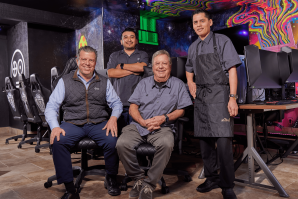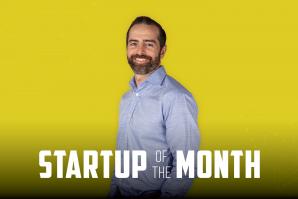Last summer at a mansion in Beverly Hills, it didn’t take long for people to notice something unique in their drinks. This was July 2022. About 150 people had shown up for the launch of the JREAM foundation, a charity to support underprivileged kids started by New York Giants star Kayvon Thibodeaux. To the sounds of hip-hop and R&B, they ate barbecue and downed cocktails on the rocks. But these rocks weren’t ordinary rocks.
Block Ice, the Sacramento-based artisan ice company and one of the event sponsors, provided innovative ice products, including custom-made cubes embedded with QR codes. Guests scanned the cubes to win prizes, and by doing so, won digital assets called NFTs (non-fungible tokens) that “introduced them to the metaverse,” says Toby Briggs, a partner at Block Ice.
Ask 100 people what the metaverse is and you might get 100 different answers. Some see it as an updated version of Second Life, the online multimedia platform that launched 20 years ago. Others envision a highly immersive 3D virtual world like in the 2018 science fiction blockbuster “Ready Player One.” And others, like Briggs, believe the metaverse will ultimately signify real-world experiences enhanced through blockchain technologies such as NFTs and cryptocurrency, which fall under the umbrella of Web3. Truth is, the metaverse is hard to define because it’s still essentially a concept in progress.
Will it be entirely virtual reality, which immerses users in an artificial environment, or utilize augmented reality, which superimposes computer-generated images in the real world? Will it be primarily a gaming and entertainment platform? Or a socioeconomic ecosystem? Or will it be — like many over-hyped ideas — a bust? One thing is certain: The technology required to create a true seamless, immersive experience isn’t here yet. As new models and applications evolve, so too will the definition of the metaverse.
“This idea that we’re going to be able to immerse ourselves in technology is really unlikely because of the challenges between different environments, and the technology we need to access it,” Briggs says. “When most people think of it, they think of ‘Ready Player One.’ I don’t think that’s the likely outcome. I’m not saying never, but not in our lifetimes.”
Terms of Engagement
For Briggs, all this talk about avatars and virtual worlds doesn’t make logistical sense. But Web3 technology, he says, is where the real money is. Different from Web2, which introduced social media, online marketplaces and cloud computing, Web3 is the newest stage of the internet. It includes technology like blockchain, digital money (e.g. Bitcoin) and digital wallets to let people take more control over their online lives by creating a more decentralized and transparent internet. With Web3, you can own and manage your digital identity and goods more securely and easily across different services.
“The metaverse will likely be a combination of Web2 and Web3 internet technologies, which will be primarily accessed via mobile devices,” Briggs says via email. “This means that most people will not engage with the metaverse in fully immersive experiences … but rather we will see a mixture of enhanced and/or exclusive experiences in entertainment, education, occupational, sports and consumer products that use technologies like NFTs to provide access to exclusive content and augmented reality (AR) to enhance in real life (IRL) experiences.”
While often used in tandem, Web3 and the metaverse are different concepts that are related and will likely work together in various ways. The metaverse can use Web3 technology to make virtual things more valuable. Web3 can use the metaverse to create cool ways for people to explore the decentralized internet.
The hype around both, however, has faded recently. The so-called “original metaverse,” Second Life, has history in the Capital Region — its San Francisco-based digital developer, Linden Labs, once held an office in Davis. But the company declined to comment for this article. Why? Well, it might have something to do with the metaverse term itself, which hasn’t exactly been viewed in the most positive light as of late, thanks to Mark Zuckerberg. The CEO of Meta (formerly known as Facebook) lost nearly $14 billion last year on his metaverse project, and he expects greater losses this year.
But a 2023 report from global IT services and consulting firm Accenture projects that consumer and business interest in the metaverse as “a tool to enhance day-to-day tasks” will catalyze a $1 trillion commerce opportunity by the end of 2025. Findings show that 70 percent of consumers plan to use the metaverse to access products and services across media and entertainment, fitness, retail, travel and health care.
To seize the opportunity in the rapidly forming metaverse industry, the report notes, businesses should get the jump on delivering tangible experiences that address consumer needs in three ways: Be creative and keep it simple, start small and focused, and engage with early building blocks, including Web3 technologies.
“Consider how the internet evolved beyond simple websites to underpin many of today’s businesses,” says Mark Noriega, Sacramento office managing director at Accenture. “Similarly, we view the metaverse as a continuum of technologies and human-centric experiences that will usher in the next era of our digital lives and transform all aspects of business.”
What is Immersive?
Regardless of the varied definitions of the metaverse, one word is common across the board: immersive. But veteran designer Mark Otero, CEO and founder of Azra Games, has never and will never use “metaverse” to describe what he creates.
“We do not see ourselves building a metaverse,” he says. “We see ourselves building a game.”
The concept of a metaverse doesn’t apply, he says, because traditional games have different aims. In an action role-playing game, for example, you go on quests, defeat monsters, collect loot. You, the player, are the hero in this world, which makes a game much more than a virtual replica of real life.
Where there is overlap is in the concept of an in-game economy, powered by Web3 technology. The ability for players to buy unique digital assets, he says, makes the gaming experience more authentic than in the past.
“When people are playing the types of games I work on, they develop a close relationship with characters they collect within the game,” Otero says. “It’s like any other relationship. You spend time investing in them. Ownership that Web3 provides can, in some cases, heighten that relationship.”
The experience is heightened because you own that digital asset and you can do things you couldn’t with other types of games. In the gaming world, digital assets can include things like virtual collectibles, weapons or other in-game items, which sometimes have real-world value and can be bought and sold in online marketplaces. Otero connects this to the real world, highlighting the difference between leasing a vehicle and owning a vehicle.
“We make role-playing games and develop immersive experiences for players, where they can role-play being the hero and collect other heroes,” Otero says. “They’re facilitating a fantasy within our game, a fantasy they might not have except within our game. That’s what we consider an immersive experience. … We, first and foremost, focus on the fantasy we want to create. Then we ask, ‘How can we maximize that experience with technology?’”
Perceived Value
As noted, Briggs freely uses the term “metaverse” to emphasize not a virtual world, but the all-encompassing role Web3 will play in virtual economies. As a father, he has seen the real-time change in the perception of value from physical things to digital possessions. His sons, ages 12 and 15, and their friends all grew up playing games — Roblox, Fortnite, Minecraft — where they create, earn and purchase digital assets.
“Kids are willing to pay for things that feel valuable to them,” he says. “Skins, themes — you have to buy those things. We have a whole generation of people who value digital things as much as real things.”
But Briggs knows trends aren’t just for kids. This is why his Auburn-based software company, Simple Learning Systems, will be using Web3 technology to issue learning certificates. In the near future, he says, NFTs (or the next gen technology) will be used to issue almost everything from drivers licenses to college diplomas.
Briggs is also president and CEO of GROW Design & Development, which handles the technology and marketing for Block Ice, a company he co-founded with his siblings Matt and Heather Briggs. The co-founders are experimenting with concepts that introduce Web3 to customers; for instance, they are considering NFT-based subscription services that include ice and other related food and drink products.
To Briggs, this all represents what the metaverse is about: more AR than VR, tools to create “richer experiences” rather than immersive ones. But similar to the metaverse, the hype around NFTs has also taken a hit in the past year. Concerns about their high prices, lack of regulation and copyright issues have contributed to plummeting sales. Anytime you have a bubble, Briggs says, it’s going to pop. Behind the scenes, though, he says everyone is still moving in this digital Web3 direction, even though fanfare has diminished.
“I’m 52 years old and I’ve been in tech a long time,” Briggs says, calling Web3 “the most exciting thing I’ve seen in tech as long as I’ve been in it. It’s a game-changer.”
‘Tech of the Day’
Every spring at UC Davis, Jesse Drew walks into his lecture hall and writes the same question on the whiteboard: “What’s the most important technology of the day?”
The class has about 200 people in it, young minds with their proverbial fingers on society’s pulse. As always, hands shoot up. Students blurt out. Drew writes their answers on the board. Despite the small sample size, his annual survey always yields interesting results.
“Last year, it was overwhelmingly TikTok,” says Drew, a professor of cinema and digital media at UC Davis. “Nobody said the metaverse.”
Drew has worked in tech for decades, going back to the 1970s. In that span, he’s seen a lot of “big ideas” come and go. In his history of media technology class, they look at the trajectories of various technologies: why some succeed, why some fail, why most disappear in a flash.
“I look at the introduction of television and radio and the computer, and what’s being called the metaverse is none of these things,” he says. “It’s more of a platform-related exercise. I wouldn’t put it in the same category as these massive things.”
Drew is familiar with Second Life. He once tried to teach a class there. He remembers universities buying virtual real estate. But people grew tired of it, and he hasn’t been back in a while. (“I think last time I was there, somebody tried to sell me drugs,” he says.) The metaverse, he believes, won’t catch on, either.
“People want to lead authentic lives, ultimately,” he says. “After a while, screen time gets old and there’s more interesting things happening out in the world. A lot of people are losing social skills. They might be locked in that little screen longer than they want to be.”
His theory tracks with the latest “dumb phone” craze. In the U.S., Gen Z has been buying vintage flip phones to spend less time scrolling and staring at mobile screens. Add this to younger generations’ care for the current state of the world — climate change, endangered animals, food quality — and you get a significant group of would-be users not so keen on immersing themselves in a virtual world, but who “will derive pleasure and crave experiences outside of that box,” Drew says.
“That shows a connection people have with living things,” he says. “People are realizing that the material world, the Earth, is finite, and that weighs on people. There’s something to be said about sunshine, green plants and living creatures, and that’s not to be found in the metaverse.”
–
Stay up to date on business in the Capital Region: Subscribe to the Comstock’s newsletter today.
Recommended For You

The Restaurant at the Edge of the Metaverse
Longtime restaurateurs open egaming-friendly diner near R Street Corridor
Go by the business that recently opened in the former home of Waffle Square Country Kitchen and there are still some remnants from what was there before, such as the brown pleather booths. Otherwise, though, something very different is going on here.

Startup of the Month: AIVision Food
An early detection tool to protect crops from pests
Insect infestation affects crops worldwide, and manually
monitoring food processing and storage facilities is a costly and
time-intensive endeavor. SmartProbe technology aims to make pest
control easier, cheaper and more effective.

Startup of the Month: Shared Vision
For influencers, Sacramento startup compiles scattered affiliate links into micro storefronts
“These content creators, they have thousands of products they’ve
recommended over thousands of posts over a dozen platforms, but
there’s no good way to manage all of those products,” Bardsley
says. “It’s not that they weren’t doing affiliate links, but they
weren’t paying attention to them enough to make money.”




